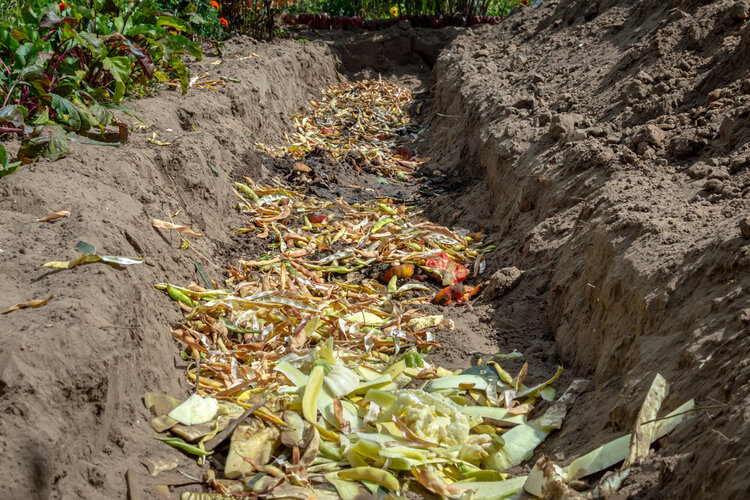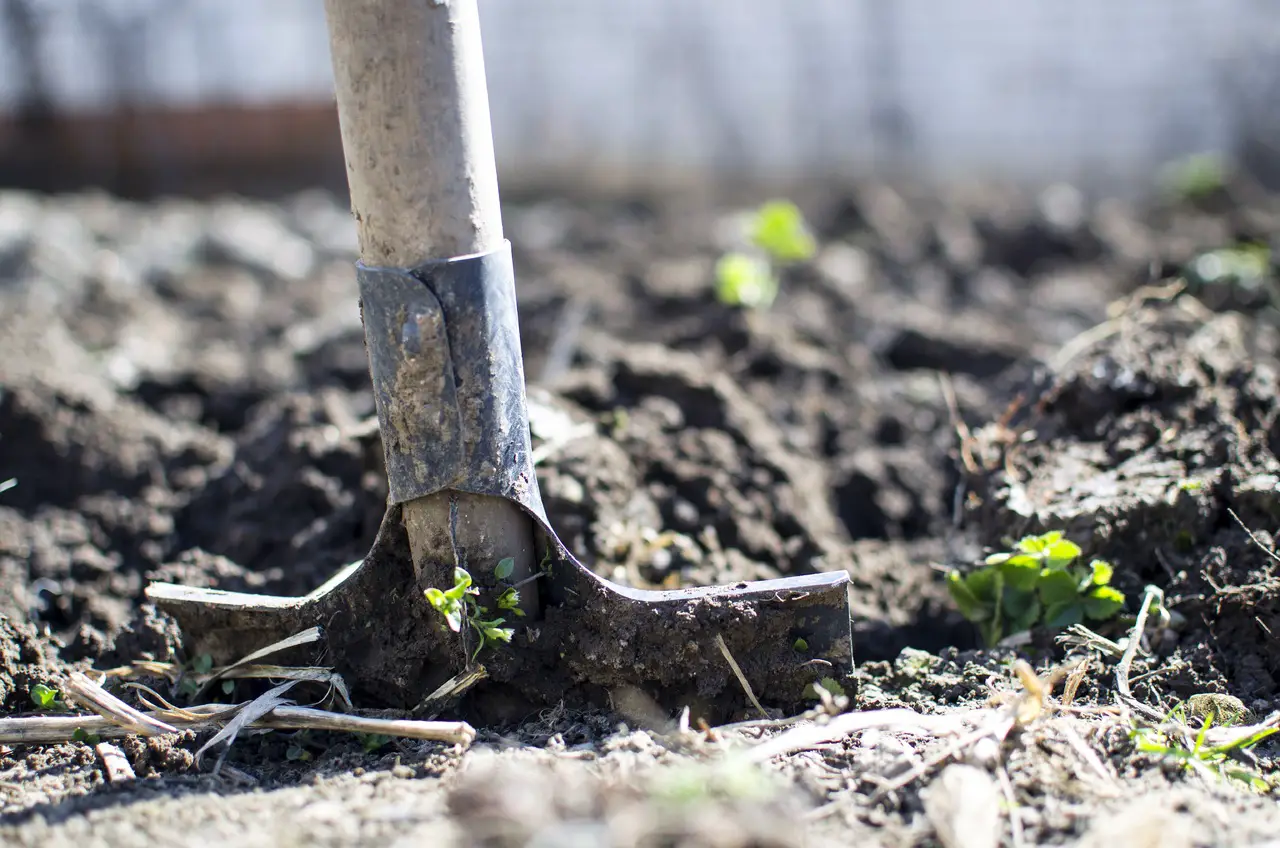You can bury your kitchen scraps in the ground to let them compost. Composting directly in the ground (trench composting) reduces organic matter from your overflowing compost bin and improves your garden’s soil texture.
Looking for a discrete yet eco-friendly method of disposing of your food waste at home? Try trench composting.
You don’t have to worry about maintaining a large compost pile because everything is buried inches deep into your garden bed and ready for planting.
Read on to find out how to prepare a proper trench compost and the benefits that come with it.
Table of Contents
What Is Trench Composting?
Trench composting/trenching is a simple yet efficient method involving burying kitchen scraps directly into your garden.
This method is especially suitable for composting animal-based by-products like eggshells, dairy, or cooked food with fats and oils because it keeps pests away.
Pests like raccoons that would’ve been attracted to the smell of rotting animal products or cooked food can’t smell the odor of the compost since it’s buried inches below the soil.
Instead, earthworms and other microorganisms are left to decompose the contents of your compost and ensure enough aeration in the soil.

What Are the Benefits of Trench Composting?
There are several benefits to trench composting, including:
1. Efficient Nutrition Supply for Plants
Plant roots dig deep into the soil to find nutrition for the growth and development of the crop.
Trench composting is done on the site allowing plants to reach the nutrients from the finished compost easily.
Earthworms also feed off the compost waste and fertilize the soil using their castings, enriching the soil further.
2. Saves on Garden Space
Trench composting is as simple as digging a hole in the ground, throwing in your food scraps, and filling the hole with the same garden soil you dug out.
Unlike a traditional compost pile that takes up a lot of space, this composting method lets you decompose large amounts of organic materials and kitchen waste efficiently within a small area.
3. Eco-Friendly
When your food waste ends up in landfills, it rots, producing methane gas which contributes to environmental pollution.
The energy and water used to grow, harvest, and transport it are also wasted unless you decide to make good use of the vegetable scraps for your flower bed.
Trench composting is one of the most eco-friendly methods because it ensures organic waste is reused for fertilizer instead of rotting in your trash.
4. It Is Odorless
Your kitchen scraps will rot and smell bad when used in a compost pile that’s improperly maintained.
Yet, when you throw your eggshells, peels, and other organic matter in your trench compost, it’s buried under inches of soil to prevent bad smells.
The odorless compost prevents pests that you’d find in a smelly compost pile.
5. Low Maintenance
A compost pile requires regular maintenance services like turning the heap once every two weeks, watering the pile when it’s dry, and adding mulch or wood chips when it’s too wet.
On the other hand, trench composts require little to no maintenance because the composting material is buried in the ground and left to earthworms for care.
You also don’t need to transport the finished compost to your vegetable garden because you can easily compost it on-site.
6. Suitable Composting Method for All Seasons
You can trench compost your kitchen waste all year round because they depend on the soil condition instead of the weather like compost piles.
Burying compost materials a few inches in your garden bed keeps the compost warm in cooler seasons and moist in dryer months which helps speed up the process.
How Deep Do You Bury Compost?
In-ground composting requires about 10 to 12 inches deep trenches when trench disposing of your kitchen scraps.
The trench can be as wide as you need it to be, and you must cover the trenches with soil after dropping your food scraps inside.
How Long Does It Take To Compost in Ground?
In-ground composting kitchen scraps take between 1 and 6 months to complete depending on several factors within your soil.
These factors include humidity, temperature, type of soil used, and the waste buried in the trenches.
You can achieve the perfect in-ground compost under the right soil conditions.
A Step by Step Guide to Trench Composting
You can practice trench composting using two methods:
- DIY in-ground compost bin
- Digging directly into your garden
DIY In-Ground Compost Bin Method
You can use an in-ground compost bin whereby you purchase a compost bin from Amazon or take the DIY approach.
Materials Needed
- Trash bin
- Tight lid
- Shovel
- Drill
Steps
- Make 3-inch holes on each side of the trash bin using the drill.
- Dig a hole in your garden that’s big enough to hold the bin and secure the bin with the lid.
- Fill the trash bin with kitchen scraps every 3 days.
- You can also create a worm farm inside the bin by adding worms like red wigglers for aeration, especially in clay soil.
- Add organic materials like wood chips or mulch to complete the worm bin and ensure a balanced ratio of food scraps to the worm farm.
- Harvest the compost after about 6 months and spread it in your garden.
Digging Directly Into Your Garden Method
With the following steps, you can trench compost your kitchen scraps all year round.
- Dig a trench that’s 1 – 2 feet deep for the process.
- Ensure the trench has an equal balance of green and brown material. For example, you can use veggie waste, peels, and grass clippings for the green material and coffee grounds, tea bags, and wood chips as brown material.
- Apple cores are also a nitrogen-rich source of nutrients for your plants.
- You can try vermicomposting by adding worms into the trench to speed up decomposition.
- Wait for about six months before planting your vegetable crops.
You can alternatively use the English System, a special composting system, for better results.
- Dig the trench, set your compost in the first year, and plant your crops alongside the path.
- The trench with compost becomes the new planting area, while last year’s planting area becomes the new compositing space.
- A new compost is ready for digging in the third year while the rest switch roles.
How To Make Compost in Ground More Active
Vermicomposting is an excellent way of making your compost more active.
The worms in this method break down organic materials into vermin-compost, which is useful for your garden.
You must also ensure a balanced mixture of greens and browns in your garden by adding organic matter such as:
- Tea bags
- Coffee grounds
- Apple cores
- Vegetable scraps
- Grass clippings
- Peels
- Wood chips
- Mulch
These ingredients create the perfect soil conditions for trench composting to happen effectively.

